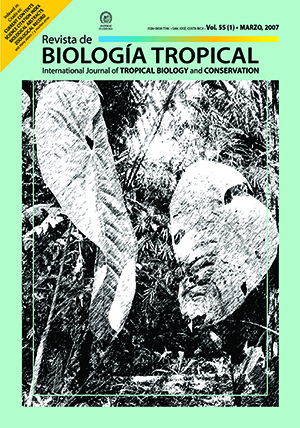Resumen
We rated some reproductive characteristics of white shrimp Litopenaeus vannamei (Boone, 1931) males using 46 farmed individuals (weighing 21.42±0.56 g) and 40 wild individuals (weighing 36.10±0.72 g). In farmed shrimps, spermatophore mean weight was 8.94±0.51 mg; total mean sperm count was 3.90±0.27 x 106 in each spermatophore; and mean percentage of normal sperm was 86.9±0.37 %. In wild individuals, the respective values were 30.68±2.32 mg; 6.22±1.09 x 106; and 62.1±3.56 %. In both groups, the differences between right and left spermatophore were not significant (p < 0.01). There were significant differences in spermatophore weight and percentage of normal sperm between farmed and wild shrimps; sperm counts differences, however, were not significant (p < 0.01). The relationship between spermatophore weight (Ws) and individual weight (Wo) was Ws (mg)=1.23 (Wo)-17.34 (r2=0.89), in farmed shrimps; and Ws (mg)=2.57 (Wo)-60.04 (r2=0.64), in wild ones. In cultivated organisms, the relationship between sperm counts (Cs) and individual weight (Wo) was Cs (x 10^6)=1.13*10-4* (Wo) 3.361 (r2= 0.85); and versus spermatophores weight was Cs (x 10^6)=0.439* (Ws) 0.984 (r2= 0.90). In wild organisms, there was no correlation. The proportion of normal sperm ranged from 79.8 to 95.2 % (86.9±0.37 %) and from 14.0 to 91.5 % (62.1±2.52 %), in farmed and wild shrimps, respectively. The most frequent abnormalities in both farm and wild animals were sperm without spike (49.3 % and 76.6 %, respectively) and irregular shape (35.8 % and 17.7 %). The less frequent occurrences were those of bent (10.2 % and 4.29 %) and double spike (4.7 % and 1.41 %).##plugins.facebook.comentarios##

Esta obra está bajo una licencia internacional Creative Commons Atribución 4.0.
Derechos de autor 2007 Revista de Biología Tropical
Descargas
Los datos de descargas todavía no están disponibles.






